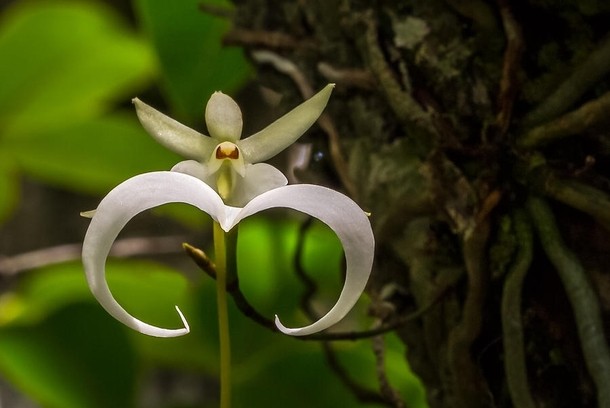White frog orchid
(Dendrophylax lindenii)

Description
Dendrophylax lindenii, the ghost orchid (a common name also used for Epipogium aphyllum) is a perennial epiphyte from the orchid family (Orchidaceae). It is native to Florida and Cuba. Other common names include palm polly and white frog orchid. The specific epithet "lindenii" is derived from its discoverer, the Belgian plant collector Jean Jules Linden, who saw this orchid for the first time in Cuba in 1844. Much later, it was also discovered in the Everglades in Florida. The genus Dendrophylax was formerly known as Polyrrhiza. Dendrophylax lindenii is a leafless epiphyte in the tribe Vandeae, in the subfamily Epidendroideae. The plant consists mainly of a network of photosynthetic roots on a tree trunk. Its habitat is moist, swampy forest in south-western Florida, and Caribbean islands such as Cuba. This orchid is exceptional among the monocots in that it consists of a greatly reduced stem, and its leaves have been reduced to scales. The flat, cord-like green roots constitute the bulk of the mature plant. They bear distinctive white "track marks", for which the technical term is pneumatodes, which are believed to function partly like stomata, enabling the photosynthetic roots to perform the gas exchange necessary for respiration and photosynthesis. Chloroplasts in these flattened roots perform nearly all the plant's photosynthesis. Their outer layer is an example of the velamen typical of most epiphytic orchids. Its functions include the absorption of nutrients and water, and admission of light for photosynthesis. The species is endangered in the wild, and cultivation has proven exceptionally difficult, but while most attempts to raise seedlings into adult plants in sterile culture end in failure, some orchidists have in fact succeeded.This orchid is listed in Appendix II of CITES and is fully protected by Florida state laws, which forbid its removal from the wild. Plants collected from the wild typically do not survive removal from their habitat, and die within a year. In the wild, Dendrophylax lindenii typically grows on the central trunk or large main branches of living trees. It seems to prefer Annona glabra (pond-apple) trees, or occasionally Fraxinus caroliniana (pop ash) trees. It tends to attach to a tree at about eye-level or a few feet higher.
Taxonomic tree:







